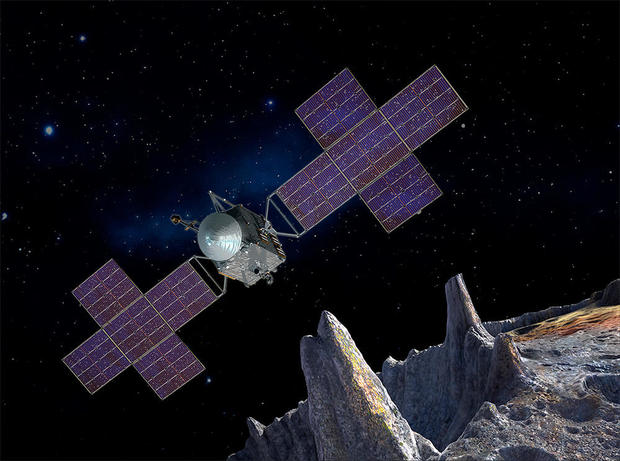A $ 1 billion mission to put an innovative spacecraft into orbit — a metal similar to the core of an early planet Around the abundant asteroid — NASA announced on Friday that it has been put on hold until next summer at the earliest due to test equipment issues and the time required to complete software testing.
As a result of independent reviews, cost-bound discovery-class psychic missions may be canceled due to budgetary impact and other factors.
"NASA takes project and program cost and schedule commitments very seriously," tweeted NASA Science Chief Thomas Zurbuchen"We are Discovery. The program, which is exploring options for psychic missions in the context of, and future path decisions will be made in the coming months. "
NASA is a project And take the cost of the program and the commitment of the schedule very seriously. We are exploring psychic mission options in the context of the Discovery Program, and decisions will be made on the future path in the coming months.
— Thomas Zurbuchen (@Dr_ThomasZ)June 24, 2022
Saiki's mission is rich in metal, similar to exposed cores. Targeting unique asteroids. Early planet. According to NASA, Saiki's mission provides a valuable opportunity to study one of the components of the early solar system.
NASA initially planned to launch the Psyche mission on August 1st. This is the start of a planetary launch window defined by its position in Earth's orbit. The location of the Sun and Psyche, the target asteroid that orbits between Mars and Jupiter.
However, in May, due to compatibility issues with a "testbed" simulator that mimics the operation of a real spacecraft, the mission manager postpones the launch on the SpaceX Falcon Heavy rocket until September 20. I was forced to do that.
A simulator assembled with Jet Propulsion Laboratory and components provided by Maxar Technologies, which provides spacecraft chassis, electric thrusters, and other key elements, provides complex probe guidance, navigation, and more. And partially needed to validate the control software. Or GN&C.
The simulator is working fine now, but the software developed in-house at JPL was delivered later than planned and the engineers are currently working. It's too late to test thoroughly. Simulator before the launch window closes on October 11th.

"There are no inherent flaws in the design and capabilities of the spacecraft to carry out its planned mission," Arizona State University reported. I told the group. "In fact, there are no known issues with the GN&C software. I just haven't tested it.
" "Today we have a beautiful and functional spacecraft. It's built and ready. But. GN&C We didn't have enough time to validate and validate the software and features related to disaster protection and fix any issues found during that test. "
Lori Glaze, Director NASA Headquarters Planetary Sciences Independent to Identify Test Bed Problems and Causes of Software Development Failures and Evaluate Launch Plans Between 2023 and 2024 Windows Said to charter a review.
NASA Managers will evaluate the additional cost of delays by reviewing the review committee's findings and recommendations from project personnel before deciding whether to continue or cancel the project. please.
"This is the result of an independent review and recommendations made by the project," Glaze said. Tally portfolio. "
The standdown also delays the testing of the high-speed laser communication equipment onboard Psyche and rides the Falcon Heavy for two independent missions through the two NASA" Small Sat "and others. asteroid.
In a news release announcing a delay in launch, NASA said, "The total cost of Psyche's lifecycle missions, including rockets, is $ 985 million, of which $ 717 million so far. Spent. Currently calculated to support each of the full range of available mission options. "

In the case of the 2022 launch, the spacecraft will arrive in Psyche in 2026. When launched in 2023 or 2024, it will arrive in 2029 and 2030, respectively. The 2023 window will open in July next year.
Each time it takes off, the spacecraft is launched onto a powerful Falcon Heavy rocket, performing a gravity-assisted flyby to speed up Mars and launching it into Pushke's course.
Guidance, navigation, and control software are essential to the success of the mission and help the spacecraft's flight computer know its exact position, Earth's position, orbit, and orientation.
"The software in the system needs to be thoroughly tested to ensure that the spacecraft can reach Psyche successfully," said JPL Director Laurie Leshin. "The software was provided, but the problem is the time required to complete testing and validation.
" To effectively operate a very complex guidance, navigation, and control test environment. There were some challenges in. This has also been fixed, but I don't think we have time to complete the testing and validation of this critical software in order to have a launch period of 2022. "

Bill Harwood has been a full-time US space program since 1984, initially as the Cape Canaveral bureau chief of United Press International, and now CBS News. As a consultant, we have covered 129 space shuttle missions. Based in the Kennedy Space Center in Florida, Harwood is an avid amateur astronomy scholar and co-author of "Comm Check: The Final Flight of Shuttle Columbia."
Thank you for reading CBS NEWS.
Create a free account or log in to
to use other features.


